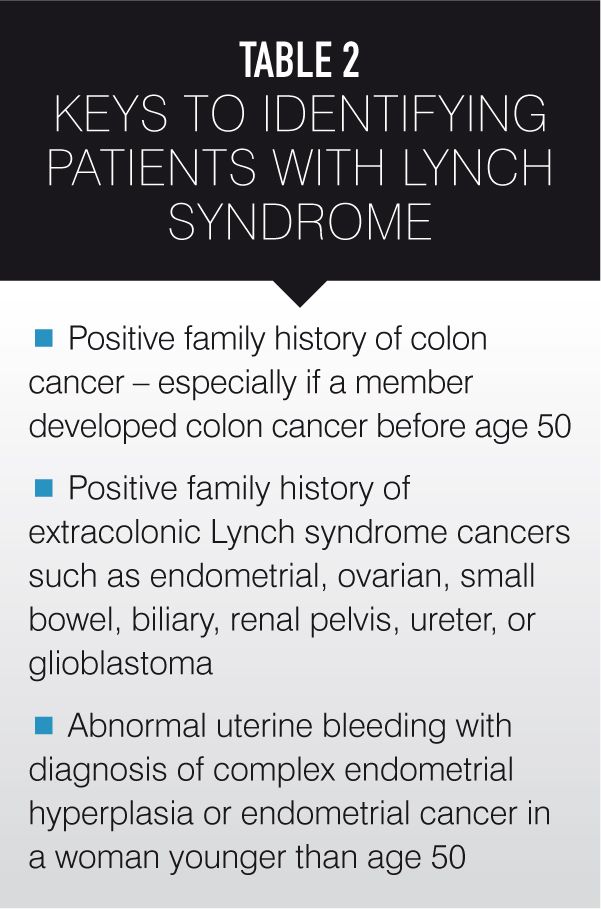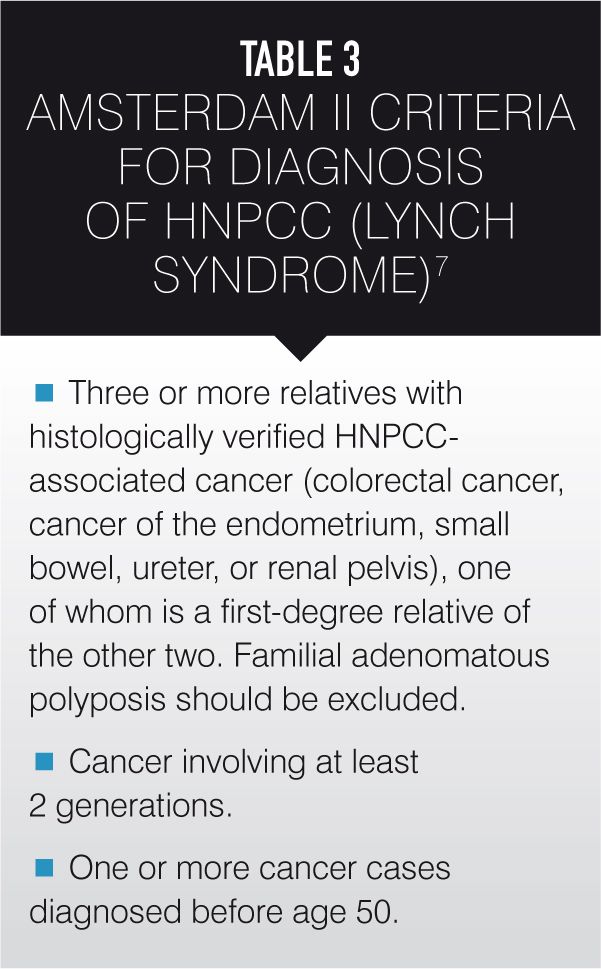Keys to identifying Lynch syndrome
Two cases illustrate the importance of and challenges inherent in diagnosing this under-diagnosed hereditary cancer syndrome in your patients.
©Photographee.eu - stock.adobe.com

Origins of Lynch syndrome

Table 1

Table 2

Table 3

Lynch syndrome is an autosomal-dominant hereditary cancer syndrome that has the same incidence in the general population as the BRCA1/2gene cancer syndrome: 1 in 400 people. But the public and physicians remain unfamiliar with this disorder partially because we have no public advocates as we have had with Angelina Jolie and the BRCA1/2genes.
In the United States, it is projected that 1 million people have Lynch syndrome, yet only 5% of them have currently been diagnosed.1 Lynch syndrome is not rare, and yet it is under-diagnosed. To identify these high-risk families before they receive a cancer diagnosis is truly practicing preventive medicine. Ob/gyns are uniquely positioned to identify these families before they develop cancer.
Lynch syndrome and cancer risk
Lynch syndrome is caused by a mutation in a DNA mismatch repair pathway. The 5 genes associated with hereditary nonpolyposis colorectal cancer (HNPCC) and their prevalences are as follows: MSH2: 60%, MLH1: 30%, MSH6: 7% to 10%, and rarely PMS2 and EPCAM.2 Usually, our healthy genes can detect mistaken genes and repair them as they are growing and multiplying. However, with Lynch syndrome, the healthy cells cannot repair the errant cells, and the body continues to make more flawed cells, which will lead to a cancer.
The predominant risk associated with Lynch syndrome, named for Henry Lynch (see Origins of Lynch Syndrome) is colon cancer, which is the third most common cancer in the United States. Three to 5 of every 100 colon cancers are a consequence of Lynch syndrome. Patients with Lynch syndrome have a 50% to 80% chance of developing colon cancer during their lifetime, and they have a 25% risk of already having colon cancer at the time of starting/commencing routine colonoscopy screening at age 50.3 Lynch-associated colon cancers are often diagnosed in adults younger than age 50, which is a red flag for hereditary cancer syndromes. Thus, it is important that any colon cancer in the patient or in the family history be evaluated in the context of additional Lynch syndrome-related cancers (endometrial, ovarian, pancreatic, etc.) so as to not miss Lynch families.4 Colorectal screening protocols for patients with Lynch syndrome differ slightly based on the specific gene mutation, but in general, include annual colonoscopies beginning at age 20 to 25.
Role of the ob/gyn
For ob/gyns, it is especially important to diagnose patients with Lynch syndrome, as a study from MD Anderson in 2005 reported that up to 71% of women identified as having it will acquire endometrial cancer (20% risk by age 50) and 12% will acquire ovarian cancer.5 That same study also showed that the sentinel/first cancer diagnosed in nearly 50% of women eventually proven to have Lynch syndrome will be a gynecologic cancer. Interestingly, a significant proportion of women with Lynch syndrome presented with simultaneous gynecologic and colon cancers. For these women, mean age at diagnosis of colorectal cancer was 40 and at diagnosis of endometrial or ovarian cancer was 44.
Due to an increased risk of both endometrial and ovarian cancers, it is important that ob/gyns be aware of the cancers associated with Lynch syndrome when taking a cancer family history of their patients (Table 1). A woman who presents with abnormal uterine bleeding and has a family history of colorectal cancer could be at risk for having Lynch syndrome, particularly if the affected member is younger than age 50 (Table 2). Once a patient with Lynch syndrome has completed child-bearing, it is appropriate to counsel her to consider a prophylactic hysterectomy and bilateral salpingo-oophorectomy. Women with Lynch syndrome who have not completed child-bearing should be followed carefully with endometrial biopsies every 1 to 2 years, starting at age 30 to 35.6 In addition, the practitioner should be more concerned about risk of endometrial cancer as the cause of bleeding in a woman with Lynch syndrome than in a typical patient who presents with such bleeding.
It cannot be emphasized enough that taking a careful cancer family history is the most effective way for a clinician to evaluate a patient for risk of having Lynch syndrome. If a patient’s personal or family history is suggestive of Lynch Syndrome, diagnostic genetic testing should be considered to confirm the diagnosis (Table 3).7 Tumor testing (MSI and IHC) of colon or endometrial cancers can be performed to look at characteristics of the cancer itself to assess the likelihood of Lynch syndrome. However, such testing is not diagnostic for Lynch syndrome nor is it a substitute for germline genetic testing.6 Ordering a hereditary cancer panel that will test for multiple cancer syndromes at one time is now the standard of care. That is important because genetic testing can distinguish between Lynch syndrome and other colorectal cancer syndromes, such as familial adenomatous polyposis (FAP) or MAP syndrome (MUTYH-associated polyposis). This is a critical distinction for women’s health care providers as these syndromes are not believed to be associated with increased risk for gynecological cancers.
Case studies
Two cases illustrate key points for ob/gyns in identifying patients with Lynch syndrome.
Case 1: 73-year-old woman
Personal and family history:
Patient – endometrial cancer at age 45 and colorectal cancer at ages 51 and 72
Sister – kidney/renal cancer at age 56
Mother - endometrial cancer at age 45
Father – colorectal cancer at age 65
Maternal aunt – breast cancer at age 65
As you can see, this patient had a personal history of both colon and endometrial cancers, the hallmark cancers of Lynch syndrome. Her case is illustrative of the findings referenced in the MD Anderson article because she had a gynecologic cancer before her first colon cancer. Unfortunately, this woman underwent cancer treatment 3 times before her history was recognized and acted upon, at age 73. Surprisingly, it was a breast radiologist-not her oncologist, ob/gyn, or colorectal surgeon-who noticed the striking history during a routine mammogram. The radiologist then suggested that a Lynch Syndrome Panel be performed, which was subsequently positive. Rather than defer to geneticists or other specialists, it is important that physicians in all specialties recognize the importance of concerning cancer histories and act upon them, so that a lifesaving diagnosis is not delayed or missed completely in these high-risk families.
Case 2: 36-year-old woman
In 2017, this patient with 5 children presented with a family history of breast and endometrial cancer in both her mother and her maternal grandmother. Because of this, she requested genetic testing. The test result came back as “negative” with a “variant of unknown significance – VUS” in the MLH1 gene. A VUS is not considered a positive result and should not clinically be acted upon. The majority of VUSs are later reclassified as benign, and responsible laboratories will monitor VUS results for a lifetime and send amended reports, should new information be obtained. Erroneously, the patient was told that she had an increased risk for both breast and endometrial cancers. Based on that discussion, she underwent bilateral mastectomies as well as a hysterectomy. Later, with subsequent interpretation of her genetic results, she brought a medical liability suit against both the ob/gyn and the breast surgeon.
For physicians who do genetic screening on a limited basis, it is prudent to send patients to an individual with expertise in evaluation of genetic risk factors and genetic testing. In this case, a genetic counselor’s expertise could have been obtained by calling a teaching university in his/her state.
Conclusion
Ob/gyns are well-positioned to identify women who may have Lynch syndrome by routinely obtaining a cancer family history from their patients. They can then discuss the importance of genetic testing with patients who may possibly meet the criteria for Lynch syndrome. As noted earlier, Lynch syndrome is an extremely under-diagnosed genetic disorder as only about 5% of Lynch syndrome carriers have been identified. Compared to breast cancer, which has a very high awareness nationally with many newspaper and television discussions, Pink Ribbon marches and events, and greater philanthropic contributions, Lynch syndrome is not well known or discussed in the United States. In 1998, Katie Couric lost her first husband at age 42 to colon cancer. Over the next 10 years, she became a national spokeswoman for colonoscopies and colon cancer. Through physician-patient discussions and education, perhaps a new national awareness about the relationship between colon cancer, other cancers, and the under-appreciated Lynch syndrome can be developed.
Disclosures:
Disclosure: Drs. Kirkpatrick and Cotton are medical consultants for Myriad Genetic Laboratories.
References:
- Kastrinos F, et al. J Clin Oncol. 2017;35(19):2165-2172.
- Ring KL, Garcia C, Modesitt SC. Current and future role of genetic screening in gynecologic malignancies. Am J Obstet Gynecol. 2017; 217(5):512-521.
- Aarnio M, Sankila R, Pukkala E, et al. Cancer risk in mutation carriers of DNA-mismatch-repair genes. Int J Cancer. 1999;81:214-218.
- NCCN Guidelines Version 1.2018 Lynch Syndrome.
- Lu KH, Lynch H, Lynch P, et al. Gynecologic cancer as a “sentinel cancer” for women with hereditary nonpolyposis colorectal cancer syndrome. MD Anderson. American College of Obstetricians and Gynecologists. Obstet Gynecol. 2005;105:569-574.
- Lynch Syndrome. ACOG Practice Bulletin No. 147. American College of Obstetricians and Gynecologists. Obstet Gynecol 2014; 124:1042-1054.
- Giardiello F, Allen J, Axilbund J, et al. Guidelines on genetic evaluation and management of lynch syndrome: a consensus statement by the US Multi-Society Task Force on Colorectal Cancer. Am J Gastroenterol. July 2014.
